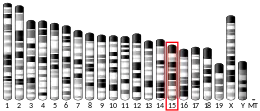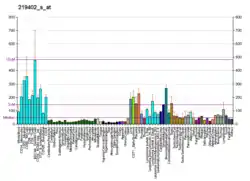Derlin-1
Derlin-1 also known as degradation in endoplasmic reticulum protein 1 is a membrane protein that in humans is encoded by the DERL1 gene.[5][6][7][8] Derlin-1 is located in the membrane of the endoplasmic reticulum (ER) and is involved in retrotranslocation of specific misfolded proteins and in ER stress.[6][8] Derlin-1 is widely expressed in thyroid, fat, bone marrow and many other tissues.[9] The protein belongs to the Derlin-family proteins (also called derlins) consisting of derlin-1, derlin-2 and derlin-3 that are components in the endoplasmic reticulum-associated protein degradation (ERAD) pathway. The derlins mediate degradation of misfolded lumenal proteins within ER,[6][8][10][11] and are named ‘der’ for their ‘Degradation in the ER’.[12] Derlin-1 is a mammalian homologue of the yeast DER1 protein, a protein involved in the yeast ERAD pathway.[6][8][12] Moreover, derlin-1 is a member of the rhomboid-like clan of polytopic membrane proteins.[10]
Overexpression of derlin-1 are associated with many cancers, including colon cancer, breast cancer, bladder cancer and non-small cell lung cancer.[13][14][15][16][17]
Discovery
In 2004 the DERL1 gene was discovered independently by two research groups when they were exploring the machinery of retrotranslocation in the ER in the cell.[6][8] One evidence for the existence of DERL1 was provided by Professor Tom A. Rapoport and his research group at Harvard Medical School, Boston, Massachusetts.[8] Another evidence of the DERL1 gene was discovered by Professor Hidde L. Ploegh and his research group who is also at Harvard Medical School, Boston, Massachusetts.[6] As the mammalian DERL1 gene was found to be a homologue of the yeast DER1 gene found in 1996,[12] it was named after the yeast gene.[6][8]
Gene location
The human DERL1 gene is located on the long (q) arm of chromosome 8 at region 2 band 4, from base pair 123,013,164 to 123,042,423 (Build GRCh37/hg19) (map).[9]
Function and mechanism
Rerouting factor during ER stress
ER stress is caused by an accumulation of unfolded or misfolded proteins in ER and is critical for cell function.[18][19] The accumulation of unfolded and misfolded proteins activates an unfolded protein response (UPR) which regulate the homeostasis of the cell.[20] One of the strategies cells possess to ER stress as a quality control system is the ERAD pathway,[20] by which Derlin-1 is a component of. As a part of an ER membrane protein complex (that includes VIMP, SEL1, HRD1, and HERP) derlin-1 detects misfolded proteins in ER and mediate them for their degradation in the ERAD pathway.[21]
Under ER stress, the carboxyl-terminus region of derlin-1 captures specific misfolded proteins in the ER lumen.[22] Derlin-1 also interacts with VIMP, an ER membrane protein that recruits the cytosolic ATPase p97 and its cofactor.[8] The interaction of derlin-1 with p97 via VIMP is essential for export of misfolded proteins. p97 is required for the transport of the misfolded proteins through the ER membrane and back to the cytosolic side for their degradation.[23] This process is referred to as retrotranslocation. Hence, one of the functions of derlin-1 is to reroute specific misfolded protein to the cytosol for their degradation.[6][8][22] Prior to the cytosolic degradation, the retrotranslocated misfolded proteins interacts with HRDI E3 ubiquitin ligase.[22] This ligase ubiquitinates the misfolded proteins promoting their degradation in the cytosol by the ubiquitin-protease system (UPS).[22] Currently, the molecular mechanism by which derlin-1 reroutes the misfolded proteins from ER to their degradation are not fully understood.
Clinical significance
Derlin 1 (DERL1) is up-regulated in metastatic canine mammary tumors as part of the unfolded protein response.[24][25][26]
Interactions
Derlin-1 has been shown to interact with the following proteins:
References
- GRCh38: Ensembl release 89: ENSG00000136986 - Ensembl, May 2017
- GRCm38: Ensembl release 89: ENSMUSG00000022365 - Ensembl, May 2017
- "Human PubMed Reference:". National Center for Biotechnology Information, U.S. National Library of Medicine.
- "Mouse PubMed Reference:". National Center for Biotechnology Information, U.S. National Library of Medicine.
- Clark HF, Gurney AL, Abaya E, Baker K, Baldwin D, Brush J, Chen J, Chow B, Chui C, Crowley C, Currell B, Deuel B, Dowd P, Eaton D, Foster J, Grimaldi C, Gu Q, Hass PE, Heldens S, Huang A, Kim HS, Klimowski L, Jin Y, Johnson S, Lee J, Lewis L, Liao D, Mark M, Robbie E, Sanchez C, Schoenfeld J, Seshagiri S, Simmons L, Singh J, Smith V, Stinson J, Vagts A, Vandlen R, Watanabe C, Wieand D, Woods K, Xie MH, Yansura D, Yi S, Yu G, Yuan J, Zhang M, Zhang Z, Goddard A, Wood WI, Godowski P, Gray A (October 2003). "The secreted protein discovery initiative (SPDI), a large-scale effort to identify novel human secreted and transmembrane proteins: a bioinformatics assessment". Genome Research. 13 (10): 2265–70. doi:10.1101/gr.1293003. PMC 403697. PMID 12975309.
- Lilley BN, Ploegh HL (June 2004). "A membrane protein required for dislocation of misfolded proteins from the ER". Nature. 429 (6994): 834–40. doi:10.1038/nature02592. PMID 15215855. S2CID 29483256.
- "Entrez Gene: DERL1 Der1-like domain family, member 1".
- Ye Y, Shibata Y, Yun C, Ron D, Rapoport TA (June 2004). "A membrane protein complex mediates retro-translocation from the ER lumen into the cytosol". Nature. 429 (6994): 841–7. doi:10.1038/nature02656. PMID 15215856. S2CID 4317750.
- "DERL1 derlin 1 [Homo sapiens (human)] - Gene - NCBI". www.ncbi.nlm.nih.gov. Retrieved 2018-11-08.
- Greenblatt EJ, Olzmann JA, Kopito RR (September 2011). "Derlin-1 is a rhomboid pseudoprotease required for the dislocation of mutant α-1 antitrypsin from the endoplasmic reticulum". Nature Structural & Molecular Biology. 18 (10): 1147–52. doi:10.1038/nsmb.2111. PMC 3196324. PMID 21909096.
- Oda Y, Okada T, Yoshida H, Kaufman RJ, Nagata K, Mori K (January 2006). "Derlin-2 and Derlin-3 are regulated by the mammalian unfolded protein response and are required for ER-associated degradation". The Journal of Cell Biology. 172 (3): 383–93. doi:10.1083/jcb.200507057. PMC 2063648. PMID 16449189.
- Knop M, Finger A, Braun T, Hellmuth K, Wolf DH (February 1996). "Der1, a novel protein specifically required for endoplasmic reticulum degradation in yeast". The EMBO Journal. 15 (4): 753–63. doi:10.1002/j.1460-2075.1996.tb00411.x. PMC 450274. PMID 8631297.
- Tan X, He X, Jiang Z, Wang X, Ma L, Liu L, Wang X, Fan Z, Su D (October 2015). "Derlin-1 is overexpressed in human colon cancer and promotes cancer cell proliferation". Molecular and Cellular Biochemistry. 408 (1–2): 205–13. doi:10.1007/s11010-015-2496-x. PMID 26173415. S2CID 18437543.
- Wang J, Hua H, Ran Y, Zhang H, Liu W, Yang Z, Jiang Y (2008). "Derlin-1 is overexpressed in human breast carcinoma and protects cancer cells from endoplasmic reticulum stress-induced apoptosis". Breast Cancer Research. 10 (1): R7. doi:10.1186/bcr1849. PMC 2374959. PMID 18205950.
- Mao M, Zhang J, Jiang J (January 2018). "Overexpression of Derlin-1 is Associated with Poor Prognosis in Patients with Non-small Cell Lung Cancer". Annals of Clinical and Laboratory Science. 48 (1): 29–34. PMID 29530993.
- Dong QZ, Wang Y, Tang ZP, Fu L, Li QC, Wang ED, Wang EH (March 2013). "Derlin-1 is overexpressed in non-small cell lung cancer and promotes cancer cell invasion via EGFR-ERK-mediated up-regulation of MMP-2 and MMP-9". The American Journal of Pathology. 182 (3): 954–64. doi:10.1016/j.ajpath.2012.11.019. PMID 23306155.
- Wu Z, Wang C, Zhang Z, Liu W, Xu H, Wang H, Wang Y, Zhang W, Wang SL (2016). "High Expression of Derlin-1 Is Associated with the Malignancy of Bladder Cancer in a Chinese Han Population". PLOS ONE. 11 (12): e0168351. doi:10.1371/journal.pone.0168351. PMC 5158059. PMID 27977784.
- Guerriero CJ, Brodsky JL (April 2012). "The delicate balance between secreted protein folding and endoplasmic reticulum-associated degradation in human physiology". Physiological Reviews. 92 (2): 537–76. doi:10.1152/physrev.00027.2011. PMC 4162396. PMID 22535891.
- Kim I, Xu W, Reed JC (December 2008). "Cell death and endoplasmic reticulum stress: disease relevance and therapeutic opportunities". Nature Reviews. Drug Discovery. 7 (12): 1013–30. doi:10.1038/nrd2755. PMID 19043451. S2CID 7652866.
- Travers KJ, Patil CK, Wodicka L, Lockhart DJ, Weissman JS, Walter P (April 2000). "Functional and genomic analyses reveal an essential coordination between the unfolded protein response and ER-associated degradation". Cell. 101 (3): 249–58. doi:10.1016/S0092-8674(00)80835-1. PMID 10847680. S2CID 17577016.
- Schaheen B, Dang H, Fares H (July 2009). "Derlin-dependent accumulation of integral membrane proteins at cell surfaces". Journal of Cell Science. 122 (Pt 13): 2228–39. doi:10.1242/jcs.048892. PMID 19509052.
- Kadowaki H, Satrimafitrah P, Takami Y, Nishitoh H (May 2018). "Molecular mechanism of ER stress-induced pre-emptive quality control involving association of the translocon, Derlin-1, and HRD1". Scientific Reports. 8 (1): 7317. doi:10.1038/s41598-018-25724-x. PMC 5943263. PMID 29743537.
- Ye Y, Meyer HH, Rapoport TA (December 2001). "The AAA ATPase Cdc48/p97 and its partners transport proteins from the ER into the cytosol". Nature. 414 (6864): 652–6. doi:10.1038/414652a. PMID 11740563. S2CID 23397533.
- Klopfleisch R, Klose P, Gruber AD (May 2010). "The combined expression pattern of BMP2, LTBP4, and DERL1 discriminates malignant from benign canine mammary tumors". Veterinary Pathology. 47 (3): 446–54. doi:10.1177/0300985810363904. PMID 20375427. S2CID 24379106.
- Klopfleisch R, Schütze M, Linzmann H, Brunnberg L, Gruber AD (January 2010). "Increased Derlin-1 expression in metastases of canine mammary adenocarcinomas". Journal of Comparative Pathology. 142 (1): 79–83. doi:10.1016/j.jcpa.2009.06.006. PMID 19632687.
- Klopfleisch R, Gruber AD (2009). "Derlin-1 and stanniocalcin-1 are differentially regulated in metastasizing canine mammary adenocarcinomas". Journal of Comparative Pathology. 141 (2–3): 113–20. doi:10.1016/j.jcpa.2008.09.010. PMID 19515379.
Further reading
- Andersson B, Wentland MA, Ricafrente JY, Liu W, Gibbs RA (April 1996). "A "double adaptor" method for improved shotgun library construction". Analytical Biochemistry. 236 (1): 107–13. doi:10.1006/abio.1996.0138. PMID 8619474.
- Yu W, Andersson B, Worley KC, Muzny DM, Ding Y, Liu W, Ricafrente JY, Wentland MA, Lennon G, Gibbs RA (April 1997). "Large-scale concatenation cDNA sequencing". Genome Research. 7 (4): 353–8. doi:10.1101/gr.7.4.353. PMC 139146. PMID 9110174.
- Katiyar S, Joshi S, Lennarz WJ (October 2005). "The retrotranslocation protein Derlin-1 binds peptide:N-glycanase to the endoplasmic reticulum". Molecular Biology of the Cell. 16 (10): 4584–94. doi:10.1091/mbc.E05-04-0345. PMC 1237066. PMID 16055502.
- Lilley BN, Ploegh HL (October 2005). "Multiprotein complexes that link dislocation, ubiquitination, and extraction of misfolded proteins from the endoplasmic reticulum membrane". Proceedings of the National Academy of Sciences of the United States of America. 102 (40): 14296–301. doi:10.1073/pnas.0505014102. PMC 1242303. PMID 16186509.
- Ye Y, Shibata Y, Kikkert M, van Voorden S, Wiertz E, Rapoport TA (October 2005). "Recruitment of the p97 ATPase and ubiquitin ligases to the site of retrotranslocation at the endoplasmic reticulum membrane". Proceedings of the National Academy of Sciences of the United States of America. 102 (40): 14132–8. doi:10.1073/pnas.0505006102. PMC 1242302. PMID 16186510.
- Schulze A, Standera S, Buerger E, Kikkert M, van Voorden S, Wiertz E, Koning F, Kloetzel PM, Seeger M (December 2005). "The ubiquitin-domain protein HERP forms a complex with components of the endoplasmic reticulum associated degradation pathway". Journal of Molecular Biology. 354 (5): 1021–7. doi:10.1016/j.jmb.2005.10.020. PMID 16289116.
- Schubert V, Da Silva JS, Dotti CG (January 2006). "Localized recruitment and activation of RhoA underlies dendritic spine morphology in a glutamate receptor-dependent manner". The Journal of Cell Biology. 172 (3): 453–67. doi:10.1083/jcb.200506136. PMC 2063654. PMID 16449195.
- Sun F, Zhang R, Gong X, Geng X, Drain PF, Frizzell RA (December 2006). "Derlin-1 promotes the efficient degradation of the cystic fibrosis transmembrane conductance regulator (CFTR) and CFTR folding mutants". The Journal of Biological Chemistry. 281 (48): 36856–63. doi:10.1074/jbc.M607085200. PMID 16954204.
- Crawshaw SG, Cross BC, Wilson CM, High S (2007). "The oligomeric state of Derlin-1 is modulated by endoplasmic reticulum stress". Molecular Membrane Biology. 24 (2): 113–20. doi:10.1080/09687860600988727. PMID 17453418. S2CID 44903284.





